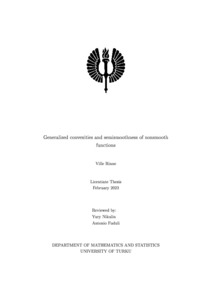Generalized convexities and semismoothness of nonsmooth functions
Rinne, Ville (2023-02-09)
Generalized convexities and semismoothness of nonsmooth functions
Rinne, Ville
(09.02.2023)
Turun yliopisto
Julkaisun pysyvä osoite on:
https://urn.fi/URN:NBN:fi-fe2023020926538
https://urn.fi/URN:NBN:fi-fe2023020926538
Tiivistelmä
This paper discusses generalizations of convexities for nonsmooth functions, or functions that are not continuously differentiable. The paper starts with some basic definitions of group theory. Next we define a convex set and a convex function and discuss some of their properties. We examine the relation between a convex set and a convex function and define a locally Lipschitz continuous function.
After that we discuss the optimization of a convex function. For this we define the subgradient of a function and prove a condition concerning the subgradient which is used to find the minimum of a convex function.
In the next chapter we discuss nonsmooth and nonconvex functions. For these functions we define the Clarke generalized directional derivative and go through some of its properties. The generalized subgradient is used to define the generalized subgradient of a function.
Next we define pseudo- and quasiconvexity for nonsmooth functions by using the Clarke generalized directional derivative. We also go through the relations between convexities and the optimality conditions of smooth and nonsmooth functions.
In the final chapter we define different kinds of semismooth functions and go through their relations between convex and generalized convex functions. We also define functions whose generalized directional derivative is well-behaved and show an important connection between well-behaved functions and generalized convexities.
After that we discuss the optimization of a convex function. For this we define the subgradient of a function and prove a condition concerning the subgradient which is used to find the minimum of a convex function.
In the next chapter we discuss nonsmooth and nonconvex functions. For these functions we define the Clarke generalized directional derivative and go through some of its properties. The generalized subgradient is used to define the generalized subgradient of a function.
Next we define pseudo- and quasiconvexity for nonsmooth functions by using the Clarke generalized directional derivative. We also go through the relations between convexities and the optimality conditions of smooth and nonsmooth functions.
In the final chapter we define different kinds of semismooth functions and go through their relations between convex and generalized convex functions. We also define functions whose generalized directional derivative is well-behaved and show an important connection between well-behaved functions and generalized convexities.
